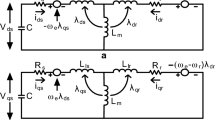Abstract
Multi-phase induction generators which may be operated in grid or self-excited mode, are found to be successful machines for wind energy conversion. Out of these two, self-excited mode is gaining importance due to its ability to convert the wind energy into electrical energy for large variations in operating speed. For this purpose, in this paper modelling and analysis in an isolated self-excited mode of dual-stator induction generator (DSIG) with a new algorithm have been done. We develop the steady-state model of a DSIG, for stand-alone renewable generation dispenses with the segregating of real and imaginary components of the complex impedance of the induction generator. Steady-state performances and characteristics of different configurations are clearly examined and compared. Simulated results as found using proposed “FZERO” algorithm are verified using experimental results on a test machine. Results obtained show that the system has sufficient capability for practical use in stand-alone power generation.













Similar content being viewed by others
Abbreviations
- C \(_1\) :
-
Excitation capacitance per phase with stator 1
- C \(_2\) :
-
Excitation capacitance per phase with stator 2
- E :
-
Air gap voltage per phase at rated frequency F
- I \(_\mathrm{s1}\) :
-
Stator 1 current per phase
- I \(_\mathrm{s2}\) :
-
Stator 2 current per phase
- I \(_r'\) :
-
Rotor current per phase, referred to stator
- I \(_m\) :
-
Magnetizing current per phase
- I \(_s\) :
-
Common stator current
- R \(_\mathrm{s1}\) :
-
Stator 1 resistance per phase
- R \(_\mathrm{s2}\) :
-
Stator 2 resistance per phase
- R \(_r\) :
-
Rotor resistance per phase, referred to stator
- V :
-
Load voltage per phase
- X \(_\mathrm{s1}\) :
-
Stator 1 reactance per phase
- X \(_\mathrm{s2}\) :
-
Stator 2 reactance per phase
- X \(_\mathrm{sm}\) :
-
Stator mutual leakage reactance per phase
- X \(_r'\) :
-
Rotor reactance per phase, referred to stator
- X \(_\mathrm{c1}\) :
-
Capacitive reactance due to C \(_1\) at rated frequency
- X \(_\mathrm{c2}\) :
-
Capacitive reactance due to C \(_2\) at rated frequency
- X \(_m\) :
-
Magnetizing reactance per phase at rated frequency
References
Ben Slimene Marwa, Khlifi Med A, Ben Fredj M, Rehaoulia H (2015) Analysis of saturated self-excited dual stator induction generator for wind energy generation. J Circuit Syst Comput 24(9):1450139
Bu F, Hu Y, Huang W, Zhuang S, Shi K (2015) Wide-Speed-Range-Operation Dual Stator-Winding Induction Generator DC Generating System for Wind Power Applications. IEEE Trans Power Electron 30:561–573
Bu F, Hu Y, Huang W, Zhuang S, Shi K (2014) Control strategy and dynamic performance of dual stator-winding induction generator variable frequency AC generating system with inductive and capacitive loads. IEEE Trans Power Electron 29:1681–1692
Ben Slimene Marwa, Khlifi Med A, Ben Fredj M, Rehaoulia H (2015) Modeling of dual stator induction generator with and without magnetic saturation. J Magnet 22(5):145–153
Singh GK (2008) Modeling and experimental analysis of a self-excited six-phase induction generator for stand-alone renewable energy generation. Renew Energy 33:1605–1621
Marwa BS, Mohamed Arbi K, Mouldi B, Habib R (2013) The process of self excitation in Dual Three-Phase induction generator. Int Rev Electr Eng 8:1738–1744
Singh GK, Senthil KA, Saini RP (2011) Performance analysis of a simple shunt and series compensated six-phase self-excited induction generator for stand-alone renewable energy generation. Energy Convers Manag 52:1688–1699
Kheldoun A, Refoufi L, Khodja DE (2012) Analysis of the self-excited induction generator steady state performance using a new efficient algorithm. Electr Power Syst Res 86:61–67
Bu F, Huang W, Hu Y, Shi K (2011) An excitation-capacitor-optimized dual stator-winding induction generator with the static excitation controller for wind power application. IEEE Trans Energy Convers 26:122–131
Haque MH (2009) A novel method of evaluating performance characteristics of a self-excited induction generator. IEEE Trans Energy Convers 24:358–365
Parsa L (2005) On advantages of multi-phase machines. Industrial Electronics Society, IECON, 31st Annual Conference of IEEE, pp 1067–1071
Amimeur H, Aouzellag D, Abdessemed R, Ghedamsi K (2012) Sliding mode control of a dual-stator induction generator for wind energy conversion systems. Electr Power Energy Syst 42:60–70
Hadiouche D, Razik H, Rezzoug A (2004) On the modeling and design of dual-stator windings to minimize circulating harmonic currents for VSI fed ac machine. IEEE Trans Ind Appl 40:506–515
Yazdani D, Khajehoddin SA, Bakhshai A, Joos G (2009) Full Utilization of the inverter in split-phase drives by means of a dual three-phase space vector classification algorithm. IEEE Trans Ind Electron 56:120–129
Wang L, Lee CH (2000) Long-shunt and short-shunt connections on dynamic performance of a SEIG feeding an induction motor load. IEEE Trans Energy Convers 15:1–7
Basic D, Zhu JG, Boardman G (2003) Transient performance study of a brushless doubly fed twin stator induction generator. IEEE Trans Energy Convers 18:400–408
Ojo O, Davidson IE (2000) PWM-VSI inverter-assisted stand-alone dual stator winding induction generator. IEEE Trans Energy Convers 36:1604–1611
Ben Slimene Marwa, Khlifi Med A, Ben Fredj M, Rehaoulia H (2014) Self excitation in dual stator winding induction generator for renewable energy generation. IEEE Con IREC, pp 1545–1551
Singh GK, Senthil Kumar A, Saini RP (2010) A self-excited six-phase induction generator for stand-alone renewable energy generation: experimental analysis. Eur Trans Electr Power 20(7):884–900
Author information
Authors and Affiliations
Corresponding author
Rights and permissions
About this article
Cite this article
Khlifi, M.A., Ben Slimene, M., Ben Fredj, M. et al. Performance evaluation of self-excited DSIG as a stand-alone distributed energy resources. Electr Eng 98, 159–167 (2016). https://doi.org/10.1007/s00202-015-0349-y
Received:
Accepted:
Published:
Issue Date:
DOI: https://doi.org/10.1007/s00202-015-0349-y




